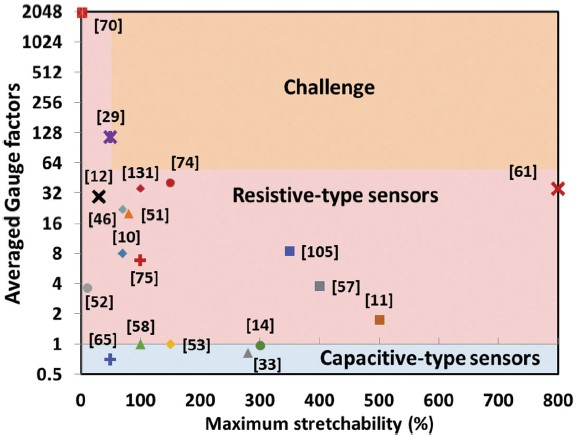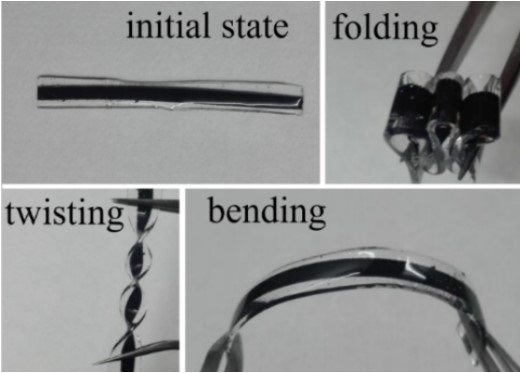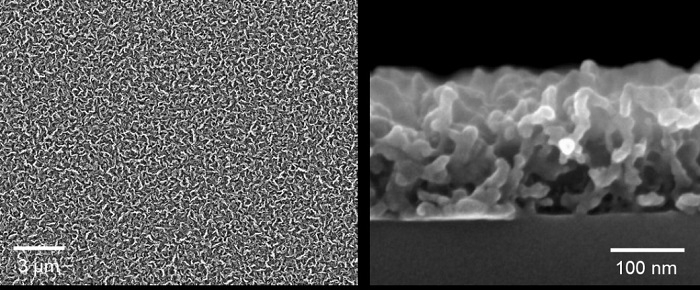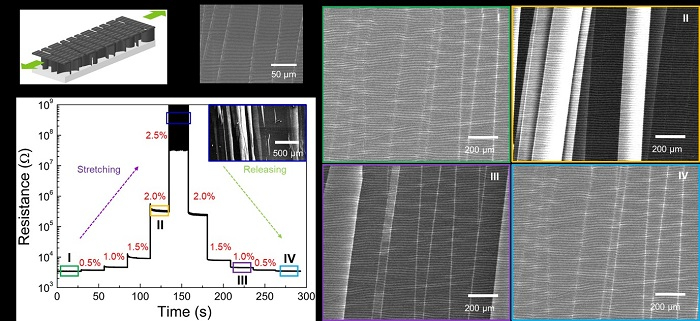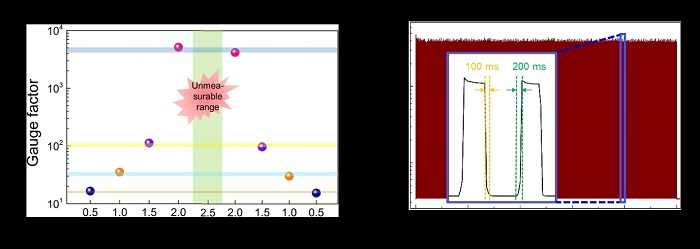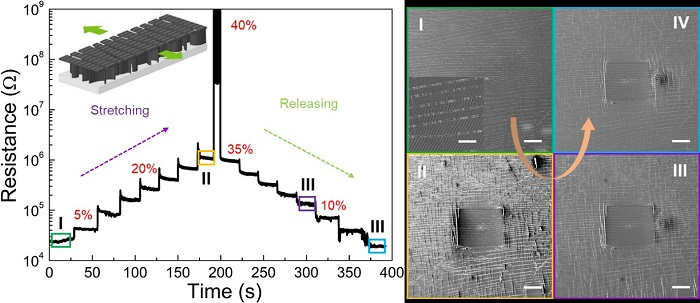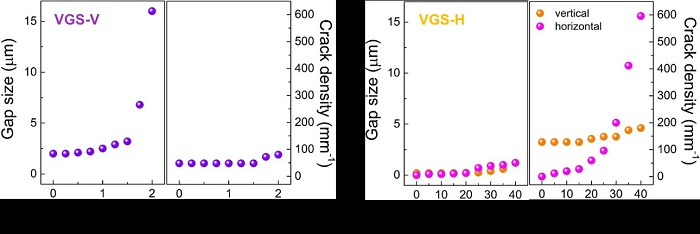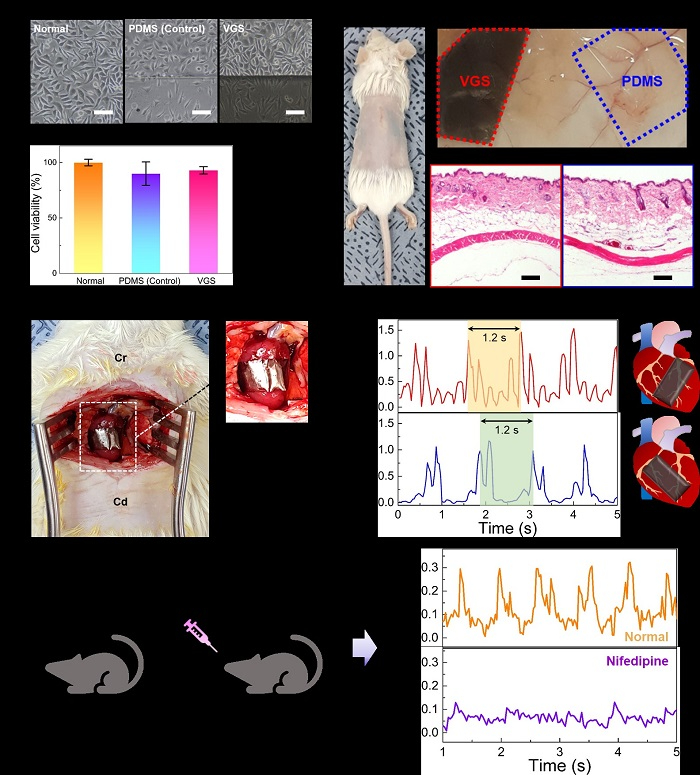SiteMap
close
Research
Research News
A prestigious global university that fosters Sejong-type talent who challenges creative thinking and communicates with the world.
|
Vertical Graphene on a Flexible Substrate 2023.08.24 147 |
|
|---|---|
|
Vertical Graphene on a Flexible Substrate Professor Seong-Hun Lee Department of Physics & Astronomy, Sejong University 1. Introduction The science and technology that affect our lives have been recently rapidly developing. The so-called 4th industrial revolution, which is expressed with AI, IoT, and big data, centered around using a large amount of information by accurately collecting and analyzing it.[1] The field that is closely related to our lives and the patterns of behavior above all is sensor technology. Sensor technology is simply the technology of detecting how much a given external stimulus is changed from its original state. A few examples are provided below. 1) Chul-soo returned from an overseas business trip in the winter. He was able to comfortably clear up things and go to bed since warmth was maintained. 2) Young-soo inspected equipment at a big factory. He felt a connection to the mysteriously twisted parts, but he didn’t know how they were actually twisted. 3) Young-hee jogs along the Hangang riverside, and he wears a smartwatch every morning for a healthy physical balance. Part of her daily routine is checking her physical condition every day according to her heart rate. 4) Old man Ilnam recently developed a problem with his heart, so he had surgery, which involved installing a pacemaker. He is relieved, because he was told that a call is made to the medical team as soon as his heart rate or vital signs become worse. All the above cases show the functions of the sensors, which inform us about the changes in the external stimuli, such as temperature, strain rate, pressure, and vibrations. Performances, such as how accurately it is possible in order to detect changes and how the possible sensitivity in regards to detecting changes greatly affect the continuation of our safe and prosperous lives. The type of sensor differs depending on what is measured as well as what the item is measured for.[2] This webzine introduces the flexible strain sensors of graphene, which the study results were recently published[3], and it examines the applicability and prospect of the strain sensors of graphene, which is called the material of dreams.
Figure 1. Wearable sensor market trend in 2020 and various examples of the applicability [2]. 2. Resistive strain sensors Sensors can be divided into electrical, mechanical, optical, and chemical sensors according to the input stimulus signal and the output scheme. The vertical graphene strain sensors, which are dealt with in this webzine, are classified as electrical sensors. It is necessary to discuss more about resistive strain sensors. Resistive strain sensors use the electrical method, which is a method of detecting changes and using them as sensors quantitatively by measuring the resistance when there is a transformation of the structure or object. The term strain means that the ratio of the length increased or decreased from the original length when a structure or object is pulled or compressed, which is also called distortion or the strain rate. Resistive strain sensors are manufactured by combining materials with high conductivity, which electricity flows well with a flexible material that can be stretched or reduced. Thus, the directions of the R&D and the development of sensors in this category are divided into two perspectives, which is due to the different strengths of the components. This is concerned with how it is possible to detect changes, such as the width of the resistance change from a sensitivity perspective and how much it is possible to stretch it in order to stably measure the resistance. However, there is a weakness, because the two problems are not compatible. The so-called trade-off, such as the meaning antinomy, which refers to the relationship where the two conflict with each other, is due to this weakness. The relationship where one factor increases when the other decreases occurs if the transformation acts on a structure or object and structural fatigue is accumulated. Thus, if it is stretched infinitely, the structure or object is destroyed, which is illustrated in Figure 2. [4,5]. This is due to the same reason, which is why a rubber band is cut but never returns to its original state when we keep stretching it. In addition, the sensitivity that was used in order to evaluate the performance of a sensor is generally defined as a change in the value of the resistance to the degree of transformation. The Gauge Factor (GF) = (R-R0)/(R0ε), and ε is length of the strain rate. It is noted that the more the degree of increase is according to the defined formula, the less the sensitivity becomes.[3] Thus, the studies about resistive strain sensors have recently been conducted into studies to make supersensitive sensors with great GF as well as studies in order to measure resistance no matter what the structural transformation may be, which include acts of stretching, twisting, folding, and crumpling.
Figure 2. Correlation between the stretchability and the gauge factor, which is the scale of the sensitivity[5]. Figure 3 illustrates an example of the supersensitive strain sensors, and there is an organ that detects the strain near the joint between the tarsus and the metatarsus of a spider[6]. This organ consists of a pad with viscosity and elasticity in the shape of the lyre in a solid exoskeleton, because it delivers the stimulus to the neural circuit when the shape of the lyre is stimulated by an external stimulus. Figure 3(c) is the strain sensor, which is made by imitating this organ. This sensor reportedly had a GF over 2,000 at a strain rate of 2%, which the sensor with a width of 1 meter stretched by 2 centimeters. The resistance that was measured was over 2,000 times the original resistance. This strain sensor shows the ability to detect resistance even with very small stimuli, such as vibrations in the air as well as small and light objects. Figure 4 is an example of a strain sensor that shows the result of a test on the maximum stretchability, which gives up GF.[7] The strain sensor, which consisted of Polyaniline (PANI) and Polydimethylsiloxane (PDMS) had a GF below 50, but it showed stable sensing functionality in spite of the experience of several transformations. It is consequently possible to decide whether to develop a supersensitive sensor or a structure with a sensor function in spite of several transformations according to the area of application and the research purpose.
Figure 3. Crack strain sensors imitating the tactile sensor in the leg of a spider[6].
Figure 4. PANI/PDMS strain sensors that are specialized in folding, twisting, and bending[7]. This study that is introduced in this webzine is concerned with vertical growth-type graphene strain sensors, which have a supersensitive function of a sensor with a GF over 5,000 as well as show the sensor role stably even in an extreme structural testing that is over 10,000. This study shows the fabrication process, the performance, and the applicability test, which was conducted and introduced in the future research plans as well as the prospects of the possible extension research. 3. Fabrication and performance of a vertical graphene strain sensor The process of the fabrication of a Vertical Graphene (VG) strain sensors is illustrated in Figure 5. First, the VG is synthesized on an SiO2/Si substrate using a plasma-enhanced chemical vapor deposition, which is depicted in Figure 5(I). After that, elastic liquid, which is PDMS, is poured on the synthesized VG in order to harden it, which is shown in Figure 5(II). The job is performed on a spin coater at this time in order to spread it evenly on the entire surface, and if RPMs exceed 1000 rpm, there is a phenomenon, which the sensor is rolled after setting it. It is carefully detached from the SiO2/Si substrate by hand after a sufficient amount of time, which is illustrated in Figure 5(III). It is then flipped over, and the VG strain sensors consist of Buffer Flat Graphene (BFG)/VG/PDSM as a result. A crack is necessarily formed on the BFG that is located at the lowest layer, because it was manually detached, which greatly affects the performance of the sensor that is mentioned later.
Figure 5. Process of fabricating a strain sensor, which vertical graphene is placed on the PDMS. This VG strain sensor has moderate hydrophobicity and transparency, and these features are essential elements of a wearable sensor. The rainwater does not permeate the cloth If one sensor is exposed to the rain in a water-proof cloth. It instead rolls down with a whirl. It should have this hydrophobicity, which is also called the lotus effect, in order to have the desired sensing function that is attached to clothes or the skin. Transparency is significantly researched for the so-called aesthetics. Figure 6 is an electron microscopic image, and the VG strain sensors are formed by intertwining at a very tight density, such as petals when they are viewed from above. In addition, when they are viewed from the side with a cross-section cut, graphene of 10-35 layers has grown on a very thin graphene layer at 2-4 nm. The length of the grown VGs is several micrometers in the previous VG studies, [8,9] whereas they have a very thin shape at the 200 nm level in this study, which plays a role in regards to subsequently showing the sensor’s unique features.
Figure 6. Ground plan and the side plan of VG synthesized on an SiO2/Si substrate. Cracks on the BFG, which is mentioned above, are regularly distributed in one direction due to the thinness, which is illustrated in Figure 7b. The wave shape between the cracks exists, which sways in a direction vertical to the cracks, is due to the Poisson effect. Changes in the resistance were measured while increasing the VG strain sensors (VGS) in a direction that was vertical to the cracks, which the result is shown in Figure 7c. The size of the VGS is 3cm, so an increase by 1% means an increase of the size of the entire sensor by 0.3 mm. The resistance sharply changes according to the extent of the increase in the VGS, because the cracks are open wide. In addition, if it increases by 2.5%, the resistance value becomes infinite, which cannot be measured. It becomes the so-called destruction of the sensors, which the current does not flow through anymore. The resistance value is amazingly restored due to this feature, which is almost the same as the condition of the resistance value before the break when VGS was restored to the original state. In other words, an amazing result was obtained, which they became immortal, and revived even though the circuit was cut. This has significant suggestions also in terms of the applicability. This shows the possibility of continuous use without tearing down and replacing them one by one when there was a breakdown with the equipment that the sensors operate it. Figure 7d illustrates a real-time electron microscopic image for each section from Figure 7c. The cracks on the surface increased as VGS was stretched, which is shown in the microscopic image, and it was discovered in real time that the state of the surface was restored to the original state when they were restored to the original state.
Figure 7. The VGS mechanical sensing performance result graph and the electron microscope image in a real-time strain status.
This amazing feature is caused by VG’s unique structure. VG forms a complex three-dimensional structure where each component lines up densely and tangles, which is shown in the ground plan and the side plan of Figure 6. Individual VGs form a conductive channel, and in the marginal stretch, which in this case is 2.5%, they completely break in some areas, and the flexible material below, which is PDMS, is torn a little bit. However, if it is released from stretching, the VGs that have been separated reconstruct the conductive channel again as if they were Velcro and return to their original state. In addition, at 2% immediately before breaking, GF was 5,200, which is the highest level of the GF among the strain sensors that were reported so far, which is shown in Figure 8a. There are a few cases that show almost the same resistance value even after experiencing serious damage as far as we know. One of the performances that is considered important with sensors is durability. We conducted a durability test more than 10,000 times by continuously stretching and releasing VGS from 0% to 2%. Figure 8b shows the results of the durability test, which there were little changes in the resistance value. It stably held the initial resistance value, which is unlike the previous cases that show some loss of the resistance value even if it reached 10,000 times. of the studies about the strain sensors until now tested durability by setting the appropriate stretchability, which considered the damage of the sensor. However, this study has significance, because it conducted durability tests more than 10,000 times by stretching 2% close to the limit, which checked the immortal trait. The movement reaction speed of VGS was 100 ms, and the recovery speed of VGS was 200 ms, which were very fast.
Figure 8. Great sensitivity test and stable durability test results
The sensor performance test was conducted this time while increasing VGS in a direction that was parallel to the cracks, which the result was shown in Figure 9. The stretchability of VGS bears improved by about 40% compared to the result of the test in the vertical direction. However, GF greatly decreased by about 34.7. This is a natural result, because the strain rate increases by 20 times while the change in resistance cannot digest the extent according to the definition of the GF. However, the same amazing phenomenon was observed even if there was serious damage to VGS, which the resistance value returned to the original state when the stretchability was reduced. There is a section in which the resistance goes to infinite, and this means that there is no current flowing. An increase that is parallel to the cracks causes a new crack that is vertical to the cracks in the real-time electron microscope image. You can easily understand if you imagine a material, such as paper, which tears when it is stretched to the side. An increase that is vertical to the cracks is called VGS-V, and an increase that is parallel to them is called VGS-H. Thus, the changes in the resistance of VGS differ, because the increase of the size of cracks greatly affects the function of the sensor for VGS-V. However, there are many new cracks for VGS-H as opposed to the expansion of the existing cracks, which is shown in Figure 10.
Figure 9. Performance result graph of VGS-H and the electron microscope image in the real-time strain condition.
Figure 10. Operation driving mechanism of VGS-V and VGS-H. 4. Applications of vertical graphene strain sensors Some application tests were conducted, which used the characteristics of VGS that are stated above. First, A Light Emitting Diode (LED), which can be used as a step-by-step alarm switch, was introduced. Most of the existing strain sensors only showed the switch’s on/off function, whereas we constructed an alarm switch where white/orange/green/blue LEDs flicker and turn on according to the stages of the resistance level by applying an Arduino UNO circuit with C++ code programming, which is shown in Figure 11. All the LEDs flickered in the marginal stretch status, which shows that the users can recognize the actual abnormal situation and return to the original state by adjusting the system. Second, this study built up a system where a signal by the wireless communication of the resistance could be detected in VGS in real time, which is illustrated in Figure 12a. This study tested if the bending of a joint could be recognized by using this system, which is shown in Figure 12b and Figure 12c. It is noted that it is successfully detected, and the signal magnitude increases with the increase of the degree of bending as well. In addition, this study also checked if it could detect various and complex vibrations of sound waves by attaching it to the speaker. Figure 12d shows the value of change in the resistance that is occurring in VGS according to the degree of the trembling of the speaker while playing Beethoven’s Symphony No.5, which was very similar to the acoustic waveform that was actually provided. The sound wave delivered via the air has a very weak vibration, so the size of the sensitivity in the strain sensors is a very important factor. The VGS that was used in this study showed super-sensitivity, which suggests that the unique characteristics in the tone via the speaker could also clearly be distinguished and detected. Lastly, this study checked the performance of the sensor via the vibration of the larynx when a language is spoken by attaching VGS to the experimenter’s neck. Two languages, which included English and Korean, were used, and the unique peak spacing for each word was determined. The amplitude of the peak differs, because it is impossible to use the same volume in the repeated experiments. These results present the applicability to the voice recognition function, which is applied as a core to the Internet of Things (IoT) for the future.
Figure 11. A snapshot image of LED observed while continuously changing the status of the stretch of VGS.
Figure 12. Wireless sensing system using VGS. Examples of the ability to detect the joint movement or distinguish the speaker’s sound wave or language. 5. Conclusion and outlook VGS included in this webzine showed amazing sensitivity and structural stability as well as an excellent mechanical performance of the sensor, which returns to the original state even if the circuit was cut. Some may doubt that it can be used as a flexible sensor, because there is no big increase. A further study could increase the degree of the increase according to the direction of the cracks on the VGS surface. In addition, it may be possible to increase the width of the resistance change by reducing the resistance level by attaching conductive nano-particles to graphene. There are many areas where the sensors show super-sensitivity so there is a lot of room to examine them in future studies, which is mentioned above. Some examples are provided below. 1) It can be used as a sensor that detects physiological medical movements that should detect microscopic vibrations and movements as opposed to the movement of the joints or muscles. Sensors typically measure the vibration of the thyroidal cartilage, the pulse, and the heart rate[10]. 2) It can also be used in pronunciation correction training, which is dealt with in the application. 3) It can operate even with microscopic pressure, so it can also be used in a system that requires the control of the microflow..[6]. 4) It can also capture a little ladybug’s movement,[6] so it can also be used in a sociological study in regards to tracking the group activity or the lifestyles of small creatures, such as insects. 5) Graphene is a biocompatible material[11], so the future of the sensors that are used by attaching them to the organs within the body as opposed to the sensors that are simply attached to the skin can be realized via graphene. This research team already conducted an experiment about a bio-friendly sensor that is used in the body by using rats and received notable research results, which is depicted in Figure 13. No cytotoxicity was observed, and there were no problems with skin irritation as well. VGS that was attached directly to the heart of a rat could most of all distinguish the left and right atriums and ventricles according to the position of the attachment, which facilitates the immediate response, which concerns the blood vessel where cardiovascular problems occur. This in vivo heart rate sensor was also used in order to conducted a drug screening evaluation by injecting calcium a channel inhibitor, which was nifedipine. A sensor is a part that is inevitable for our lives in the 2020s, and it is also a precious technology that is used for electronic devices, which make our future prosperous. Graphene, which is called the material of dreams, is applied to various areas by transforming its dimension and shape. VG in this study is also an example of the structural transformation of graphene. VG that can capture the movement of various organs in the body is expanded from the mechanical utilization. It will be a material that will lead the development of future science and technology aspects. This study was jointly conducted with Prof. Yong-ju Yoon’s research team at the Graduate School of Energy and Environment, Korea University and Prof. Si-yun Kim’s research team at the College of Veterinary Medicine, Konkuk University and supported by a research foundation.
Figure 13. Experiment on the function of in vivo biocompatible strain sensors using VGS. References [1] https://blog.lgcns.com/1349 [2] J. Heikenfeld et al., Wearable sensors: modalities, challenges, and prospects. Lab Chip 2018, 18, 217-248. [3] S. Lee et al., Vertical graphene on flexible substrate, overcoming limits of crack-based resistive strain sensors. npj Flex. Electron. 2022, 6, 2. [4] B. Park et al., A semi-permanent and durable nanoscale-crack-based sensor by on-demand healing. Nano scale 2018, 10, 4354-4360. [5] M. Amjadi et al., Stretchable, skin-mountable, and wearable strain sensors and their potential applications: A review. Adv. Funct. Mater. 2016, 26, 1678-1698. [6] D. Kang et al., Ultrasensitive mechanical crack-based sensor inspired by the spider sensory system. Nature 2014, 516, 222-226. [7] X. X. Gong et al., Flexible strain sensor with high performance based on PANI/PDMS films. Org. Electron. 2017, 47, 51-56. [8] S. Wu et al., Ultrasensitive and stretchable strain sensors based on maze-like vertical graphene network. ACS Appl. Mater. Interfaces 2018, 10, 36312-36322. [9] C. Deng et al., Ultrasensitive and highly stretchable multifunctional strain sensors with timbre-recognition ability based vertical graphene. Adv. Funct. Mater. 2019, 29, 1907151. [10] J. Tolvanen et al., Stretchable and washable strain sensor based on cracking structure for human motion monitoring. Sci. Rep. 2018, 8, 13241. [11] K. Kostarelos and K. S. Novoselov, Graphene devices for life. Nat. Nanotechnol. 2014, 9, 744-745. |
|
| Next | Trends in the Development of Brilliant Color Alloy Technology |
| Previous | Technological Trends and Development Directions in Predicting Mine Burial Rates |

